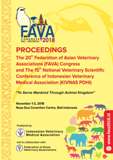FA-7 Practical Applications of Ultrasound for Pregnancy Diagnosis in Bali Cattle Herded Semi-Intensively in Maumere, NTT
Abstract
Generally, real time, B-mode ultrasound scanner has become an essential part for veterinary reproduction applications. Diagnostic ultrasound seems to be a useful tool to study anatomical structures and to confirm echogenic pattern in reproductive organ (Holman et al, 2011). Many experiments showed that ultrasonography imaging has considerable beneficial for the evaluation of the internal structure of reproductive organ function in domestic animals (Beal et al, 1992) as it can be used as a non-invasive technique to evaluate animal reproductive health (Holman et al 2011). Pregnancy detection with ultrasonography provides more advantage compare to manual palpation because of its ability to detect early presence of embryo and its accuracy (Beal et al, 1992; Nation et al 2003). To the best of our knowledge, most of cattle farmers and veterinarians in Maumere have relied on one single method for detecting pregnancy in cows, that is, rectal palpation. However, this method has its limitation as it should be performed by a skillful technician to diagnose pregnancy as early as 40 days of gestation and it does not provide any information about the viability of the embryo or fetus. Therefore, this study aims to investigate pregnancy status of Bali cattle herded semi-intensively in Maumere, NTT by using ultrasonography.
The objective of the research was to study the practical uses of ultrasound for pregnancy detection in Bali cattle on B-mode ultrasound imaging.

